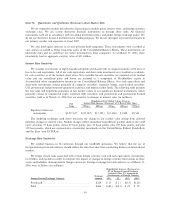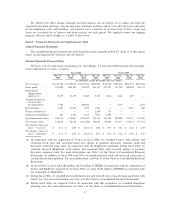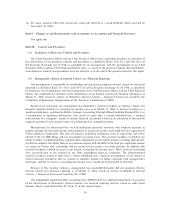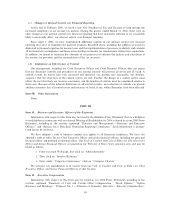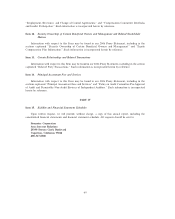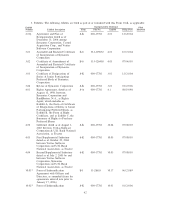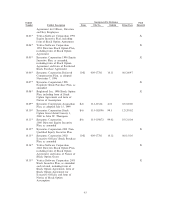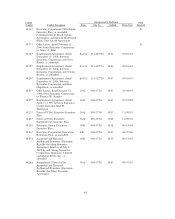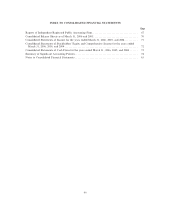Symantec 2006 Annual Report Download - page 62
Download and view the complete annual report
Please find page 62 of the 2006 Symantec annual report below. You can navigate through the pages in the report by either clicking on the pages listed below, or by using the keyword search tool below to find specific information within the annual report.
Item 7A. Quantitative and Qualitative Disclosures about Market Risk
We are exposed to market risk related to fluctuations in market prices, interest rates, and foreign currency
exchange rates. We use certain derivative financial instruments to manage these risks. All financial
instruments used are in accordance with our global investment policy and global foreign exchange policy. We
do not use derivative financial instruments for trading purposes. We do not anticipate any material changes in
our primary market risk exposures in fiscal 2007.
We also hold equity interests in several privately-held companies. These investments were recorded at
cost, and are classified as Other long-term assets in the Consolidated Balance Sheets. These investments are
inherently risky and we could lose our entire investment in these companies. As of March 31, 2006, these
investments had an aggregate carrying value of $11 million.
Interest Rate Sensitivity
We consider investments in highly liquid instruments purchased with an original maturity of 90 days or
less to be cash equivalents. All of our cash equivalents and short-term investments are classified as available-
for-sale securities as of the balance sheet dates. Our available-for-sale securities are reported at fair market
value and any unrealized gains and losses are included as a component of Stockholders' equity in
Accumulated other comprehensive income in our Consolidated Balance Sheets. Our cash equivalents and
short-term investments consist primarily of corporate securities, corporate bonds, asset-backed securities,
U.S. government and government-sponsored securities, and money market funds. The following table presents
the fair value and hypothetical changes in fair market values of our significant financial instruments, which
primarily consist of commercial paper, corporate debt securities, and government and government backed
securities, held as of March 31, 2006 that are sensitive to changes in interest rates (in millions):
Hypothetical Fair Market Values Given an
Interest Rate Increase (Decrease) of X Basis Points (bps)
Fair
Value 150 bps 100 bps 50 bps (25 bps) (75 bps)
Significant financial
instruments ÏÏÏÏÏÏÏÏÏÏÏÏ $1,517,037 $(11,087) $(7,392) $(3,696) $1,848 $5,544
The modeling technique used above measures the change in fair market value arising from selected
potential changes in interest rates. Market changes reflect immediate hypothetical parallel shifts in the yield
curve of minus 75 basis points, minus 25 basis points, plus 50 basis points, plus 100 basis points, and plus
150 basis points, which are representative of potential movements in the United States Federal Funds Rate
and the Euro Area ECB Rate.
Exchange Rate Sensitivity
We conduct business in 36 currencies through our worldwide operations. We believe that the use of
foreign exchange forward contracts should reduce the risks that arise from conducting business in international
markets.
We hedge certain risks associated with certain foreign currency cash and cash equivalents, investments,
receivables, and payables in order to minimize the impact of changes in foreign currency fluctuations on these
assets and liabilities denominated in foreign currencies. Foreign exchange forward contracts as of March 31,
2006 were as follows (in millions):
Hypothetical Increase (Decrease) in
FV of Foreign Forward Exchange
Contracts Given X% Appreciation
(Devaluation) of Foreign Currency
Notional
Foreign Forward Exchange Contracts Amount 10% 5% (5)% (10)%
PurchasedÏÏÏÏÏÏÏÏÏÏÏÏÏÏÏÏÏÏÏÏÏÏÏÏÏÏÏÏÏÏÏÏÏÏÏÏÏÏ $228 $ 21 $ 11 $(12) $(25)
SoldÏÏÏÏÏÏÏÏÏÏÏÏÏÏÏÏÏÏÏÏÏÏÏÏÏÏÏÏÏÏÏÏÏÏÏÏÏÏÏÏÏÏÏ $446 $(41) $(21) $ 23 $ 50
56












